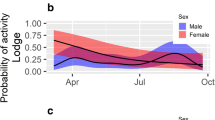Abstract
Asiatic ibex (Capra sibirica) is a threatened species in China and is distributed in the mountains of Central Asia. It is a sexually dimorphic ungulate. The males are much larger than females, and except for the breeding season, both sexes live in separate groups. Many hypotheses have been developed to explain the sexual segregation in sexually dimorphic ungulates. These hypotheses are not mutually exclusive, and in recent years, the activity budget hypothesis has received special attention. To test this hypothesis, we studied the activity budget of Asiatic ibex in the autumn of 2005. According to the activity budget hypothesis, females should spend more time feeding than the males, and the degree of activity synchronization should be higher in same-sex groups than in mixed-sex groups. Our results are consistent with the hypothesis. Both sexes of the Asiatic ibex spent most of the time feeding, and females spent a significantly longer time feeding than males, and males spent a significantly longer time standing. Activity synchronization indexes of both the female groups and males groups were significantly higher than mixed-sex groups. These results indicated that in Asiatic ibex, the activity budget hypothesis about sexual segregation is supported.

Similar content being viewed by others
References
Bon R (1992) In: Spitz F, Janeau G, Gonzalez G, Aulagnier S (eds) Social and spatial sexual segregation of polygamous ungulates: proximate factors. Ungulates. S.F.E.P.M, Paris, pp 195–198
Bon R, Campan R (1996) Unexplained sexual segregation in polygamous ungulates: a defense of an ontogenetic approach. Behav Process 38:131–154
Bon R, Rideau C, Villaret JC, Joachim J (2001) Segregation is not only a matter of sex in Alpine ibex, Capra ibex. Anim Behav 62:495–504
Bunnell F, Gillingham M (1985) In: Hudson R, White R (eds) Foraging behavior: dynamics of dining out. Bioenergetics of wild herbivores. CRC Press, Boca Raton, pp 53–79
Conradt L (1998) Could asynchrony in activity between the sexes cause intersexual social segregation in ruminants? Proc Biol Sci 265:1359–1363
Fedosenko AK, Blank DA (2001) Capra sibirica. Mammalian species 675:1–13
Gu Z (1990) Primary survey of ibex population of Albin Mountain. Science and Technique of Bazhou 3:6–10
Li Z, Jiang Z (2008) Sexual segregation in Tibetan gazelle: a test of the activity budget hypothesis. J Zool 274:327–331
Main MB (2008) Reconciling competing ecological explanations for sexual segregation in ungulates. Ecology 89:693–704
Main MB, Weckerly FW, Bleich VC (1996) Sexual segregation in ungulates: new directions for research. J Mammal 77:449–461
Martin P, Bateson P (1993) Measuring behaviour: an introductory guide. Cambridge University Press, Cambridge
Michelena P, Noel S, Gautrais J, Gerard JF, Deneubourg JL, Bon R (2006) Sexual dimorphism, activity budget and synchrony in groups of sheep. Oecologia 148:170–180
Mooring MS, Fitzpatrick TA, Benjamin JE, Fraser IC, Nishihira TT, Reisig DD, Rominger EM (2003) Sexual segregation in desert bighorn sheep (Ovis canadensis Mexicana). Behaviour 140:183–207
Ruckstuhl KE (1998) Foraging behaviour and sexual segregation in bighorn sheep. Anim Behav 56:99–106
Ruckstuhl KE (1999) To synchronise or not to synchronise: a dilemma for young bighorn males? Behaviour 136:805–818
Ruckstuhl KE (2006) Sexual segregation in ungulates: proximate and ultimate causes. Integr Comp Biol 46:E122
Ruckstuhl KE, Kokko H (2002) Modelling sexual segregation in ungulates: effects of group size, activity budgets and synchrony. Anim Behav 64:909–914
Ruckstuhl KE, Neuhaus P (2000) Sexual segregation in ungulates: a new approach. Behaviour 137:361–377
Ruckstuhl KE, Neuhaus P (2002) Sexual segregation in ungulates: a comparative test of three hypotheses. Biol Rev 77:77–96
Ruckstuhl KE, Manica A, Maccoll ADC, Pilkington JG, Clutton-Brock TH (2006) The effects of castration, sex ratio and population density on social segregation and habitat use in Soay sheep. Behav Ecol Sociobiol 59:694–703
Shi JB, Dunbar RIM, Buckland D, Miller D (2003) Daytime activity budgets of feral goats (Capra hircus) on the Isle of Rum: influence of season, age, and sex. Can J Zool 81:803–815
Van Soest PJ (1994) Nutritional ecology of the ruminant, 2nd edn. Cornell University Press, New York
Wang TZ, Fang RS, Chen FG, Min ZL, Luo SY, Zhou HZ (1983) Wildlife resource of Beita Mountain in Altay Mountains. Chinese Wildlife 4:53–55
Wang XY (1985) The biology resources of Tomur Area of Tian Shan Mountains. Xinjiang People Press, Urumqi, p 353
Wang S (1998) China red data book of endangered animals: mammalia. Science Press, Beijing
Xu F, Ma M, Wu YQ (2007a) Distribution of the ibex (Capra ibex ) in Tomur National Nature Reserve of Xinjiang, China. Zool Res 28:670–672
Xu F, Ma M, Wu YQ (2007b) Population density and habitat utilization of ibex (Capra ibex) in Tomur National Nature Reserve, Xinjiang, China. Zool Res 28:53–55
Yearsley IM, Perez-Barberia FJ (2005) Does the activity budget hypothesis explain sexual segregation in ungulates? Anim Behav 69:257–267
Zar JH (1999) Biostatistical analysis, 4th edn. Prentice-Hall, New Jersey
Acknowledgments
The research is supported by the Science Supporting Project of the National Ministry of Science and Technology (2008BAC39B04) and the National Natural Science Foundation of China (30470262, 30970340). We thank the Xinjiang Forestry Bureau and the Tomur National Nature Reserve Management Bureau for supporting our research. We thank Patricia Johnston for editing our manuscript. We thank Chundawat for helping in planning the research, and Kuban, Mulamin for helping with the field work.
Author information
Authors and Affiliations
Corresponding author
Additional information
Communicated by P. Acevedo
Rights and permissions
About this article
Cite this article
Xu, F., Ma, M., Yang, W. et al. Test of the activity budget hypothesis on Asiatic ibex in Tian Shan Mountains of Xinjiang, China. Eur J Wildl Res 58, 71–75 (2012). https://doi.org/10.1007/s10344-011-0542-x
Received:
Revised:
Accepted:
Published:
Issue Date:
DOI: https://doi.org/10.1007/s10344-011-0542-x




